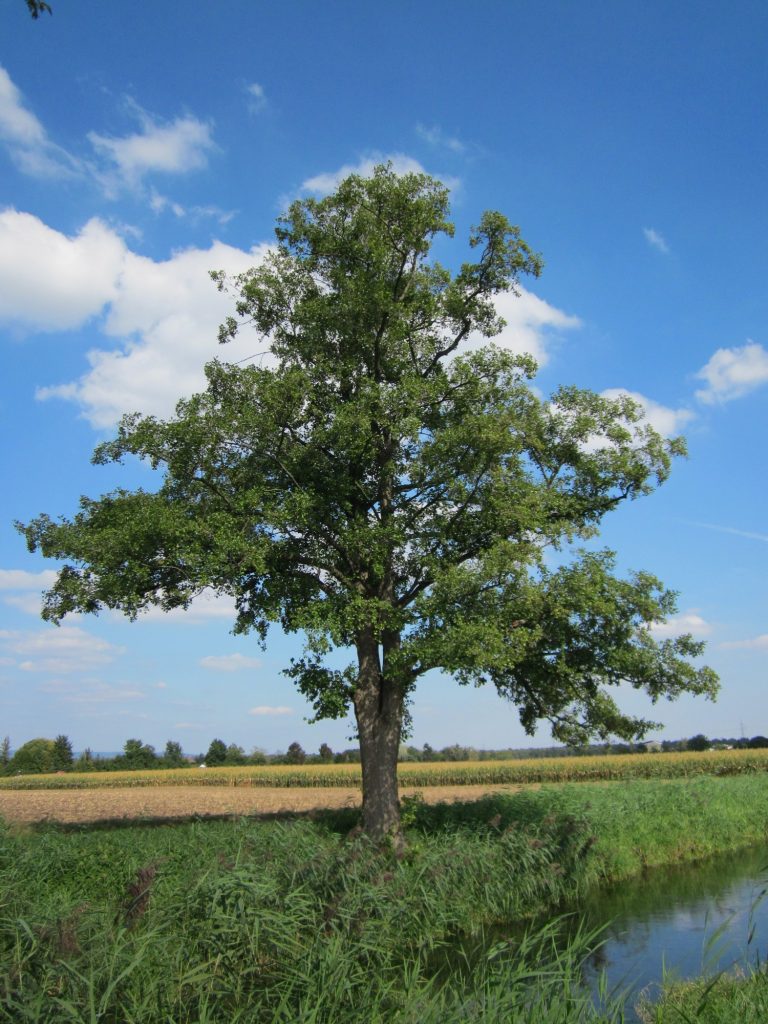Once again, we explore the thirteen month Ogham (oh-am) Tree Calendar to see what unique wisdom this month’s tree has to offer us on our life journey.

In April, we celebrate the Alder tree as we enter the fourth moon of the Ogham calendar, ruled by Fearn (pronounced verern).
Alder, the magical tree of Bran, King of the Celts, can be found close to water. It favours European forests and woods where there’s a river bank, a lake edge, a winding stream or marshy meadow land. Alder is a fantastic spiritual guide as it is known as ‘the giver of courage and easer of fear and doubt’.
Alder’s magical properties stem from its roots which span the space between earth and water, resting in the two elements – the faery space of betwixt and between. Common alder is a deciduous, medium height tree, growing quickly but only living to around 150 years. Small groups of alder – ‘alder carrs’ – sometimes form, but they usually grow in narrow bands, standing side-by-side, winding their way along the streams.
The trees often have more than one rough, grey-barked trunk and when an original tree dies, new shoots may form at its base. Young bark, and fresh leaves are slightly sticky, hence the name ‘alnus glutinosa’. .
Alder is a ‘pioneer tree’, the first to inhabit damp, treeless ground. A special bacterium found in alder takes nitrogen from the air and enriches the soil improving it alongside its deep roots that bind the banks and help reduce erosion. Alder trees are a vital feature of the ecology of wetlands as their matted roots spread into the water to give shelter to fish and invertebrates who eat their quickly rotting leaves.
Above the damp ground, the grey, spindly looking branches and dark green, round, tooth-edged leaves play host to unusual mosses and lichens, to insects, and a special moth – the Alder Kitten Moth.
Unusually, in spring, the tree flowers, male and female in the one plant (this is known as monoecious). The male ones grow as long, purplish-golden catkin tassels, while the female flowers develop as tiny cones of about 5 – 7mm. These are round and green at first, opening to shed their minute winged seeds, and turning woody and dark brown.
Alder is the only British native deciduous tree to have cones, and they stay on the tree through the winter and into next spring, so you see the long catkins plus the new green and the old brown cones on the branches at the same time, before the fresh leaves appear.
Alder wood is oily and water resistant turning very hard when underwater, so it’s been used historically to make foundations and stilts for platforms, bridges, lake-dwellings and roads.

Dark Legends – and Ancient Magic
Pre-Christian stories tell of King Bran ‘The Blessed’, a.k.a. Bran the God, or Bran the Giant, who carries a sacred staff made of Alder. His bird is the raven. As Alder rules the 4th Lunar month of the Ogham Tree Calendar, it is fitting that the Raven is the 4th Lunar month of the Ogham Bird Calendar. Perhaps, Bran’s character in Game of Thrones was constructed based off some of these associations.
As legend has it, Alder trees that grow in wild, untamed landscapes function as portals into the Underworld. To enter the faerie kingdom (if you dare!), one must pass through a door in the trunk which sits just above the waterline.
Dark and mysterious faeries live in these places, and when they don’t want to be seen, they’ll fly from the branches as crows, or even take the form of a raven.
Listen closely and you will hear the music of the alder flute floating through the door cracks, winding its way through the topmost ‘singing’ branches out to the stars.
Perhaps, one tree is even home to the Elven King. The amber coloured sap that rises in late spring is known as elf-blood.
So, what does Fearn, our ancient Alder, offer us as learning in our own journey as OFN Ireland?
‘The wood of this tough tree doesn’t rot when waterlogged, instead turning stronger and harder.’ (The Woodland Trust UK).
Alder is a symbol of resilience as once the main tree dies new shoots spring forth from it’s base to continue the tree’s lifespan through many trunks. Its ability to thrive both on land and in water shows us its adaptability and unique power of resourcefulness. These three characteristics are key to OFN as we journey to creating a fairer food system.
We like that Alder is the ‘Giver of Courage and Easer of Fear and Doubt’. We wish to emulate the Alder and provide our members with the tools they need to succeed. Thus, our community is based on the ethos of knowledge and resource sharing – we even have a dedicated ‘Support‘ section on our website alongside our new training programme specifically for this purpose.
Alder Magic, Charms and Beliefs
* Take care with Alder use in any magical workings – the tree blends all four power elements and can be unpredictable and fickle in the extreme. If you need to pick from the tree, it is essential to leave a gift in return, or to care for the environment round about.
* Form a little amulet with an equal armed cross of alder wood, adding the cones if you have them, and carry it to help with doubt or fear in a stressful situation. Any part of the tree used as a charm (if gathered correctly) will bring courage.
A larger one makes an attractive and meaningful decoration.
* A whistle or pipe from alder (the central pith of a thick twig will come out quite easily with care) will summon the faery folk, or, being a capricious instrument, the North Wind!
♡ ♡ ♡
[Text adapted from Eco Enchantments ‘The Thirteen Trees of the Ogham Moon Calendar ‘
Photos from FirstNature]